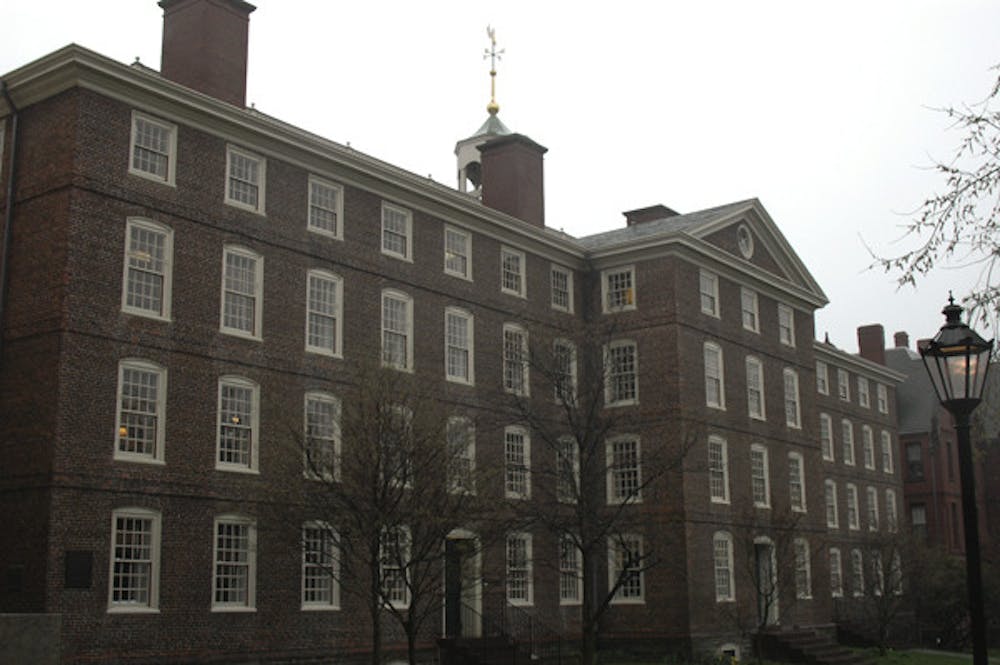Updated Feb. 10.
The Corporation approved a 3.8 percent increase in undergraduate tuition and fees as part of the University’s fiscal year 2015 budget, President Christina Paxson announced in a community-wide email Saturday afternoon.
The tuition hike will raise next year’s total undergraduate costs per student to $59,428.
The Corporation also approved a 5.5 percent increase in financial aid expenditures, supporting about $104.1 million in undergraduate scholarships for the estimated 44 percent of students eligible for need-based aid. The decision marks the first time in University history that the financial aid budget has eclipsed $100 million.
The expansion of financial aid will allow the average student scholarship to grow by about 5 percent, according to a University press release.
The University’s fiscal year 2015 operating budget will climb 3.2 percent from this year’s, bringing total expenditures to $941.5 million. This spending will be offset by only $937.7 million in revenues, requiring the University to draw from its reserves to compensate for the $3.8 million deficit.
Budgeting and growth
The projected use of reserves is down from the $4.4 million budgeted for this year and the $9 million in fiscal year 2013 but is still unsustainable over the long haul, Paxson wrote.
Though the University has drawn on its reserves each of the last three years to make up for an operating deficit, it achieved a balanced budget as recently as fiscal year 2012, Provost Mark Schlissel P’15 told The Herald.
The anticipated use of $3.8 million in reserves constitutes just under half of one percent of total expenditures, Schlissel said, adding that larger-than-expected research grants or financial gifts could create a balanced budget.
But expenses are often unpredictable as well. “Unexpected things come up,” Schlissel said, citing this year’s heightened campus safety concerns, which led the University to increase spending in order to extend the Brown University Shuttle service and hire additional yellow jacket security officers.
Financial aid expenditures this year also exceeded the budgeted amount. Next year’s financial aid projection marks an increase of 9.3 percent over the current budget’s allotment.
“Things come up that outstrip our ability to cover the costs by increasing revenue,” said Schlissel, who chairs the University Resources Committee, which recommends a budgetary blueprint to the president each year.
Balancing the University’s needs with the desire to curb tuition increases is “always a hard trade-off every year,” Schlissel said. “We try to increase the budget as little as possible, and then figure out how to use our various sources of revenue to pay for what’s necessary. And in the current economy, it’s a challenge.”
Paxson said the scale of future tuition increases would depend largely on inflation. Next year’s tuition hike is about 2 percent above the current inflation rate, but Paxson said she hopes to be able to bring tuition increases more in line with inflation in the years to come.
Renovations on dorms and other projects drove this year’s budget uptick, said Beppie Huidekoper, executive vice president for finance and administration. But budget increases have remained steady over the past few years and are smaller than those of the last decade, she said.
The budget for next year will be the first to include the new School of Public Health, Huidekoper said.
Next year’s budget accounts for the 1 percent growth of the undergraduate population — from 6,040 to 6,100 students — that Paxson outlined in her strategic plan approved by the Corporation last fall. The growth will provide the University with an expanded tuition base.
The plan also calls for corresponding faculty growth, but hiring will be slowed this year after “spectacularly successful” faculty searches last year led to greater expansion than intended, Schlissel said. The University aims to average 1 percent faculty growth per year over the next decade in order to maintain the current faculty-to-student ratio, he said.
The pool for faculty and staff salaries will increase by about 3 percent, Huidekoper said. Graduate stipends are also slated to increase 3.7 percent, Paxson wrote in her email.
Capital campaign
The Corporation authorized Paxson, the Corporation’s Committee on Advancement and the University’s Division of Advancement to begin “preliminary planning” for a capital campaign but did not give serious thought to a launch date or fundraising target, Schlissel said.
Chancellor Thomas Tisch ’76 said the Corporation gave its “resounding support” for a comprehensive fundraising campaign as part of a larger effort of “working in an organized and active way to fulfill the goals of ‘Building on Distinction.’”
Huidekoper said she does not know the details of the timeframe for launching a new capital campaign, but added that Corporation members discussed the need for one at their meeting.
“There is an awareness of the 250th (anniversary) as a moment for the community to look back and also to look forward,” Tisch said of general timing for a campaign.
The University expects a small decline in Brown Annual Fund donations due to the lack of an ongoing campaign, she said. The University also expects a 5 percent decline in sponsored research, according to the press release.
Gifts and development
The Corporation gave the University the go-ahead to hire an architect for a new engineering building, Tisch said, calling it “a very big step.”
Tisch said the Corporation also discussed the University’s “tremendous capacity” for interdisciplinary engagement, teaching and research, citing brain science as a particularly dynamic area of integrative scholarship.
One of the gifts the University accepted was $1 million to support fellowships for doctoral students conducting research in collaboration with the Brown Institute for Brain Science, Paxson wrote in the email.
The Corporation also discussed the implementation of the Laboratory for Educational Innovation — another component of the strategic plan — which will develop online content for courses taught on campus and will exist under the umbrella of the Sheridan Center for Teaching and Learning, Schlissel said.
The Corporation considered “preliminary sets of data and surveys and assessments” the University could employ to measure the progress of the strategic plan, Paxson said.
The University accepted over $26 million in total gifts and created several new endowed professorships, including positions for a professor on nuclear security policy and an assistant professor at the School of Public Health who will focus on the intersection of health care, technology and communications.
The University accepted a gift of $1 million from Ron Beller ’83 and Jennifer Moses ’83 to support a new initiative to provide students on financial aid with one guaranteed summer of internship or research funding.
The Corporation expressed “a lot of enthusiasm” for the new internship program, as well as a pilot program to attract more top-notch graduate students, Paxson told The Herald.
“We raised about $170 million in total last year and I think (we expect) to raise that much this year again overall,” Huidekoper said. “We’re feeling pretty good about the donations.”

ADVERTISEMENT




